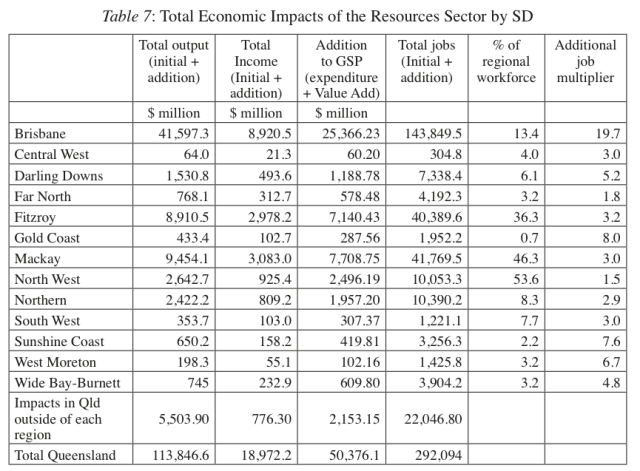Following my post last week on the Brisbane Economic Development Plan, an informed reader suggested that the source of the eyebrow-raising resources sector jobs multiplier of 19 may have been the Queensland Resources Council-sponsored study of the sector’s economic contribution that I blogged about last year (That sure is a mining boom).
It looks likely that the Resources Council-sponsored study, published in the March 2011 edition of Economic Analysis and Policy, is indeed the source as it identifies an “additional job multiplier” for Brisbane of 19.7 (see Table 7 reproduced below). You can’t calculate the multiplier of 19.7 from numbers in Table 7 as you need the estimate of people directly employed by the resources sector residing in Brisbane (6,940 people) from Table 5 earlier in the paper. Once you have this, you can work out the multiplier by taking the estimated total jobs in Brisbane due to the resources sector (direct and indirect) of 143,850, subtracting the number of people directly employed, that is 6,940, and then dividing by 6,940 to get how many jobs there are in Brisbane indirectly due to the resources sector for every job directly due to the sector.
While I now understand how the multiplier of 19 quoted in the Brisbane Economic Development Plan is calculated, I’m still skeptical about whether it makes any sense to calculate it on a regional rather than a Statewide basis. The almost 137,000 Brisbane-located jobs that are indirectly supported by the resources sector (according to the modelling presented in the paper) are related to resources sector activity across the whole State. Hence direct resources sector employment across the whole of Queensland would be the appropriate denominator, not the number of resources sector employees residing in Brisbane (i.e. only 6,940 people).
On a Statewide basis, the modelling in the paper finds there are an additional 6-7 jobs for every one job directly created by the resources sector in Queensland. But I still feel this is too high and the study may be over-estimating the sector’s indirect impacts. This is because it counts jobs indirectly created by jobs indirectly created by jobs directly created in the resources sector. For example, it may count a barista who has a job in a swanky Eagle St cafe serving consultants from Big 4 firms performing audit or due diligence work for mining companies. This is tracing the chain of causation one step further than many economists think is sensible.


Thank’s for the illumination and not before time that the use of industry multilpiers was more widely discussed!
A quiite recent and very good post below. However, there is still an economic consulting industry built on multiliers?
http://www.agrifood.info/connections/2009/Rama_Lawrence.html
Thanks for that link. I think multipliers still have a place in economic impact assessment, but economists need to be clear about the uncertainty around their magnitude and that their size depends on the prevailing level of unemployment and supply capacity in the region. If an economy is already running near potential, then stimulus is more likely to simply shift resources between sectors than generate new activity (as David Gruen mentioned in that senate estimates answer you referred me to the other week).